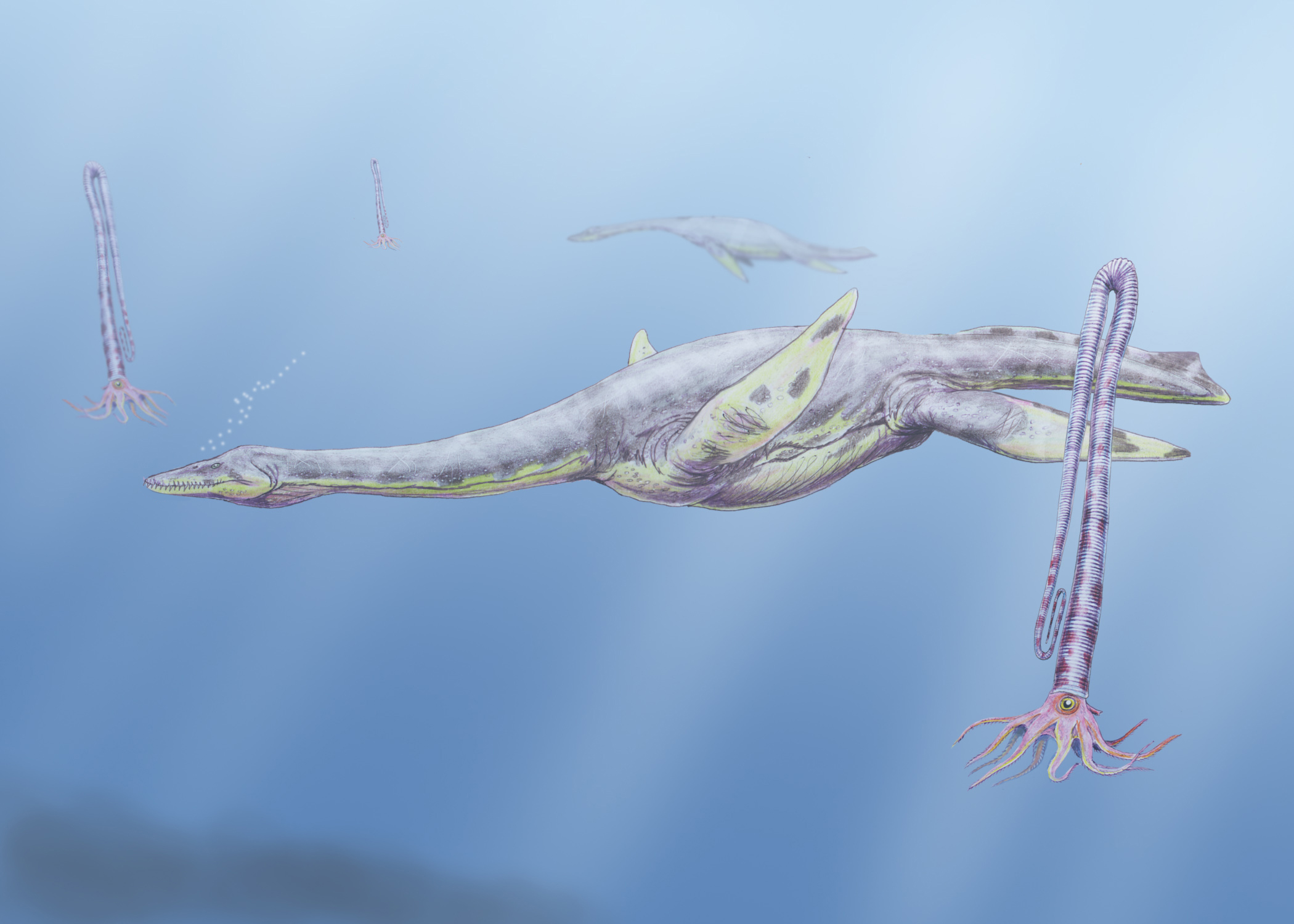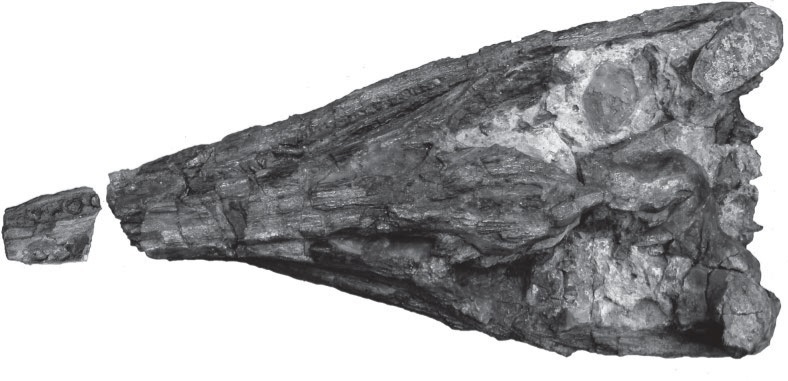|
Lorrainosaurus
''Lorrainosaurus'' is an extinct genus of thalassophonean pliosaurid from the Middle Jurassic of Lorraine, France. Discovery and naming The holotype specimen ( MNHNL BU159) was discovered during a temporary excavation for a roadway upgrade between the Montois-la-Montagne and Sainte-Marie-aux-Chênes communes in Lorraine, France. The remains consisted of a near-complete mandible, coracoid shoulder bone, a tooth, and fragments of the upper jaw and front limb. They specifically originated from a section of the Marnes de Gravelotte, a marl deposit dated to the Bajocian stage of the Middle Jurassic around 168 mya. The specimen first came under the study of paleontologist Pascal Godefroit in 1994, who described it as a new species of ''Simolestes'' and assigned the name ''S. keileni''. The generic identification was doubted by the PhD thesis of Noè (2001),Noè, L. F. (2001). A taxonomic and functional study of the Callovian (Middle Jurassic) Pliosauroidea (Reptilia, Sauropterygia ... [...More Info...] [...Related Items...] OR: [Wikipedia] [Google] [Baidu] |
Pliosauridae
Pliosauridae is a family of plesiosaurian marine reptiles from the Latest Triassic to the early Late Cretaceous ( Rhaetian to Turonian stages). The family is more inclusive than the archetypal short-necked large headed species that are placed in the subclade Thalassophonea, with early, primitive forms resembling other plesiosaurs with long necks. The largest thalassophonean pliosaurs reached , in length, with around a quarter of this length being the head. Thalassophonean pliosaurs represented the largest marine predators during their existence, spanning more than 80 million years. Pliosaurs went extinct during the early Late Cretaceous and were subsequently replaced by the mosasaurs. Taxonomy Pliosauridae was formally named by Harry G. Seeley in 1874. Pliosauridae is a stem-based taxon defined in 2010 (and in earlier studies in a similar manner) as "all taxa more closely related to '' Pliosaurus brachydeirus'' than to '' Leptocleidus superstes'', '' Polycotylus latipin ... [...More Info...] [...Related Items...] OR: [Wikipedia] [Google] [Baidu] |
Timeline Of Plesiosaur Research
This timeline of plesiosaur research is a chronologically ordered list of important fossil discoveries, controversies of interpretation, Taxonomy (biology), taxonomic revisions, and cultural portrayals of plesiosaurs, an order of marine reptiles that flourished during the Mesozoic Era. The first scientifically documented plesiosaur fossils were discovered during the early :19th century in paleontology, 19th century by Mary Anning. Plesiosaurs were actually discovered and described before dinosaurs. They were also among the first animals to be featured in Paleoart, artistic reconstructions of the ancient world, and therefore among the earliest prehistoric creatures to attract the attention of the lay public. Plesiosaurs were originally thought to be a kind of primitive transitional form between marine life and terrestrial reptiles. However, now plesiosaurs are recognized as highly derived marine reptiles descended from terrestrial ancestors. Early researchers thought that plesiosau ... [...More Info...] [...Related Items...] OR: [Wikipedia] [Google] [Baidu] |
Thalassophonea
Pliosauridae is a family of plesiosaurian marine reptiles from the Latest Triassic to the early Late Cretaceous (Rhaetian to Turonian stages). The family is more inclusive than the archetypal short-necked large headed species that are placed in the subclade Thalassophonea, with early, primitive forms resembling other plesiosaurs with long necks. The largest thalassophonean pliosaurs reached , in length, with around a quarter of this length being the head. Thalassophonean pliosaurs represented the largest marine predators during their existence, spanning more than 80 million years. Pliosaurs went extinct during the early Late Cretaceous and were subsequently replaced by the mosasaurs. Taxonomy Pliosauridae was formally named by Harry G. Seeley in 1874. Pliosauridae is a stem-based taxon defined in 2010 (and in earlier studies in a similar manner) as "all taxa more closely related to '' Pliosaurus brachydeirus'' than to '' Leptocleidus superstes'', '' Polycotylus latipinnis ... [...More Info...] [...Related Items...] OR: [Wikipedia] [Google] [Baidu] |
Lorraine
Lorraine, also , ; ; Lorrain: ''Louréne''; Lorraine Franconian: ''Lottringe''; ; ; is a cultural and historical region in Eastern France, now located in the administrative region of Grand Est. Its name stems from the medieval kingdom of Lotharingia (855–959 AD), which in turn was named after either Emperor Lothair I or King Lothair II. Lorraine, originally the southern or "upper" part of this kingdom, came to be ruled by the Holy Roman Empire as the Duchy of Lorraine before the Kingdom of France annexed it in 1766. From 1982 until January 2016, Lorraine was an administrative region of France. In 2016, under a reorganisation, it became part of the new region Grand Est. As a region in modern France, Lorraine consisted of the four departments Meurthe-et-Moselle, Meuse, Moselle and Vosges (from a historical point of view the Haute-Marne department is also located in the region), containing 2,337 communes. Metz is the regional prefecture. The largest metropolitan area ... [...More Info...] [...Related Items...] OR: [Wikipedia] [Google] [Baidu] |
List Of Plesiosaur Genera
This list of plesiosaurs is a comprehensive listing of all genera that have ever been included in the order Plesiosauria, excluding purely vernacular terms. The list includes all commonly accepted genera, but also genera that are now considered invalid, doubtful (''nomen dubium''), or were not formally published (''nomen nudum''), as well as junior synonyms of more established names, and genera that are no longer considered plesiosaurs. The list currently includes genera. Scope and terminology There is no official, canonical list of plesiosaur genera but one of the most thorough attempts can be found on the Plesiosauria section of Mikko Haaramo's Phylogeny Archive; also pertinent is the Plesiosaur Genera section at Adam Stuart Smith's Plesiosaur Directory.See Smith, ''Plesiosaur Genera''. Naming conventions and terminology follow the International Code of Zoological Nomenclature. Technical terms used include: * Junior synonym: A name which describes the same taxon as a previously ... [...More Info...] [...Related Items...] OR: [Wikipedia] [Google] [Baidu] |
Simolestes
''Simolestes'' (meaning "snub-nosed thief") is an extinct pliosaurid genus that lived in the Middle to Late Jurassic. The type specimen, NHMUK PV R 3319 is an almost complete but crushed skeleton diagnostic to ''Simolestes vorax'', dating back to the Callovian of the Oxford Clay formation, England. The genus might also be known from the Tithonian Bhuj Formation of India (''S.indicus''), however the referral of this species to ''Simolestes'' is dubious. ''S.keileni'' from France was moved to the new genus ''Lorrainosaurus'' in 2023. Description ''Simolestes'' possessed a short, high, and wide skull which was built to resist torsion (mechanics), torsional forces when hunting. The largest specimens of ''S. vorax'' reached approximately in length, if a head to body ratio similar to ''Liopleurodon'' is applied. Palaeobiology Like most pliosaurs, ''Simolestes'' possessed salt glands, salt secreting glands, which would have enabled the animal to maintain salt balance and drink seaw ... [...More Info...] [...Related Items...] OR: [Wikipedia] [Google] [Baidu] |
Paleontologist
Paleontology, also spelled as palaeontology or palæontology, is the scientific study of the life of the past, mainly but not exclusively through the study of fossils. Paleontologists use fossils as a means to classify organisms, measure geologic time, and assess the interactions between prehistoric organisms and their natural environment. While paleontological observations are known from at least the 6th century BC, the foundation of paleontology as a science dates back to the work of Georges Cuvier in 1796. Cuvier demonstrated evidence for the concept of extinction and how life of the past was not necessarily the same as that of the present. The field developed rapidly over the course of the following decades, and the French word ''paléontologie'' was introduced for the study in 1822, which was derived from the Ancient Greek word for "ancient" and words describing relatedness and a field of study. Further advances in the field accompanied the work of Charles Darwin who popu ... [...More Info...] [...Related Items...] OR: [Wikipedia] [Google] [Baidu] |
Stenorhynchosaurus
''Stenorhynchosaurus'' is an extinct genus of pliosaurid plesiosaurs which lived in the Early Cretaceous of South America. The type species and only known is ''Stenorhynchosaurus munozi''. Etymology The genus name is derived from the Greek words ''stenos'', "narrow"; ''rhynchos'', "snout" and ''sauros'', "lizard", while the specific name ''munozi'' is in recognition of Jorge Muñoz by discover and report the fossil. Discovery and naming Fossils from the front of a snout of a plesiosaur were discovered in 2000 on the property of Jorge Muñoz, in Loma La Cabrera, near Villa de Leyva in Boyacá, Colombia, on grounds of marine origin dating from the Late Barremian age of the Cretaceous. Muñoz reported the find to the local authorities, who in turn gave notice to staff of the Museo Geológico José Royo y Gómez administered by the Servicio Geológico Colombiano in Bogotá. Then was made the excavation of the nearly complete skeleton between 2004 and 2005, in collaboration ... [...More Info...] [...Related Items...] OR: [Wikipedia] [Google] [Baidu] |
Ancient Greek
Ancient Greek (, ; ) includes the forms of the Greek language used in ancient Greece and the classical antiquity, ancient world from around 1500 BC to 300 BC. It is often roughly divided into the following periods: Mycenaean Greek (), Greek Dark Ages, Dark Ages (), the Archaic Greece, Archaic or Homeric Greek, Homeric period (), and the Classical Greece, Classical period (). Ancient Greek was the language of Homer and of fifth-century Athens, fifth-century Athenian historians, playwrights, and Ancient Greek philosophy, philosophers. It has contributed many words to English vocabulary and has been a standard subject of study in educational institutions of the Western world since the Renaissance. This article primarily contains information about the Homeric Greek, Epic and Classical periods of the language, which are the best-attested periods and considered most typical of Ancient Greek. From the Hellenistic period (), Ancient Greek was followed by Koine Greek, which is regar ... [...More Info...] [...Related Items...] OR: [Wikipedia] [Google] [Baidu] |
Portmanteau
In linguistics, a blend—also known as a blend word, lexical blend, or portmanteau—is a word formed by combining the meanings, and parts of the sounds, of two or more words together.Garner's Modern American Usage p. 644. English examples include '' smog'', coined by blending ''smoke'' and ''fog'', and '''', from ''motor'' ('' motorist'') and ''hotel''. A blend is similar to a [...More Info...] [...Related Items...] OR: [Wikipedia] [Google] [Baidu] |
Apomorphy And Synapomorphy
In phylogenetics, an apomorphy (or derived trait) is a novel character or character state that has evolved from its ancestral form (or plesiomorphy). A synapomorphy is an apomorphy shared by two or more taxa and is therefore hypothesized to have evolved in their most recent common ancestor. ) In cladistics, synapomorphy implies homology. Examples of apomorphy are the presence of erect gait, fur, the evolution of three middle ear bones, and mammary glands in mammals but not in other vertebrate animals such as amphibians or reptiles, which have retained their ancestral traits of a sprawling gait and lack of fur. Thus, these derived traits are also synapomorphies of mammals in general as they are not shared by other vertebrate animals. Etymology The word —coined by German entomologist Willi Hennig—is derived from the Ancient Greek Ancient Greek (, ; ) includes the forms of the Greek language used in ancient Greece and the classical antiquity, ancien ... [...More Info...] [...Related Items...] OR: [Wikipedia] [Google] [Baidu] |








